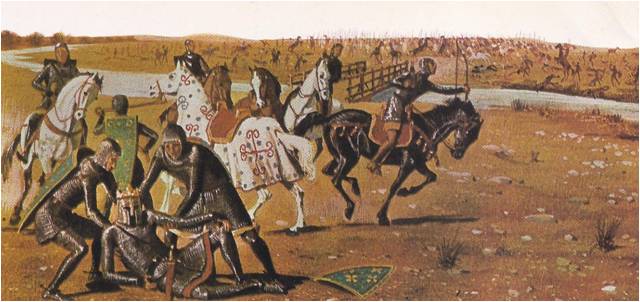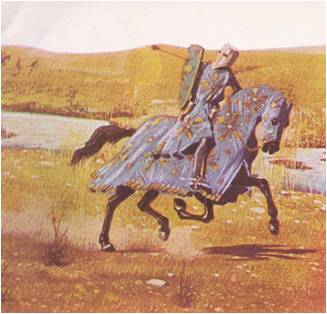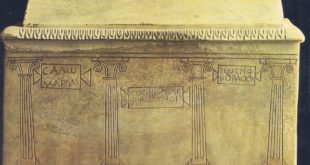AFTER THE BREAKUP OF CHARLEMAGNE’S Empire, France, the western half of the empire, was ruled by a series of weak kings. They were so weak that they were known as the “do-nothing kings,” and indeed, they could do nothing to stop their powerful and greedy nobles from fighting among themselves. Finally the Carolingian line came to an end and the Franks, as the French were then called, elected a new king. He was Hugh Capet, a relative of the famous Count Odo who had directed the defense of Paris against the Vikings.
With Hugh began the line of Capetian kings who were to rule France for many generations. The king actually held several positions. He was the sovereign of a vaguely defined nation called France; at the same time he was the feudal lord of his own lands and overlord, of Suzerain, of all other French lords. He was supposed to be defender of the realm, protector of the poor and champion of justice, but he was actually little more than a figurehead, for he had neither soldiers nor money enough to enforce his authority.
Like the German monarchs, the Capetian kings faced the problem of winning control of the powerful lords. Also like the Germans, they took the first step by establishing good relations with the Church. In their coronation oath, the French kings swore to defend the Church. In return, for hundreds of years, the Church supported the monarchy against the feudal lords.
The hereditary fief of the French kings was the Ile de France, a small, compact area surrounding Paris and it was infested by lawless vassals who terrorized the roads leading to the city. King Louis VI waged war against them. The French nicknamed him Louis the Fat, but his enormous size did not harm his ability to fight. He showed the outlaws no mercy and one by one, they were suppressed, exiled, or executed. Among them was Thomas of Marle, who was famous for his cruelty. Once, when a peasant told him that he was unable to walk fast, Thomas shouted, “I’ll make you bestir yourself !” — and sliced off the peasant’s feet with one blow of his sword.
With the Ile de France firmly under control, Louis the Fat’s successor, Louis VII, began to bring vassals in other parts of the realm to justice. He summoned them to court and if they refused to appear, he went after them with an army. Louis VII also continued Louis the Fat’s policy of reorganizing the central government. The two kings discharged incompetent nobles and replaced them with men of lower birth who were loyal to the crown.
HENRY OF ANJOU
The biggest obstacle to the French kings’ drive for power was the mighty duchy of Normandy on the northern coast of France. The duke of Normandy was supposed to be a vassal of the king, but in 1066, William, the duke of Normandy, crossed the English Channel with an army and conquered England. According to feudal law, the French king was still the overlord of the duke of Normandy — and the duke, by his conquest of England, was now a king in his own right.

Things grew even more complicated in 1151. By this time a young man named Henry was the duke of Normandy. The grandson of an English king, he became known as Henry of Anjou. He inherited the French duchies of Anjou, Maine and Tourraine — and these, together with the lands he already owned, made him the lord of a vast estate, much larger than the kingdom of France.
Meanwhile, in 1137, King LouisVII had married fifteen-year-old Eleanor of Aquitaine, heiress of one of the largest and richest duchies of France. Beautiful, talented and ambitious, Eleanor found neither her royal husband nor his court much to her liking. They were not lively enough for her. She once said that she thought she had married a king, but found that she had married a monk. Louis, on the other hand, was very much in love with her. He was extremely jealous — and Eleanor gave him more than one reason to be. Finally, when she was with him on the second crusade, Louis was so humiliated by her shameless conduct that he decided to divorce her. Louis got his divorce on March 21, 1152. On May 18, to Louis’ surprise, Eleanor married Henry of Anjou. The following year, her new husband became king of England and was called Henry II. Almost two-thirds of France was in his hands, while Louis controlled only half of the other third.

THE CAPETIANS
Henry founded the line of English kings known as the Angevin kings and it seemed impossible that they would not crush the Capetian kings of France. The Capetians now had less power than their former vassals and yet for three hundred years the Capetians held on to what was theirs; in the end they pushed the Angevins out of France. During the three-hundred-year struggle the real French nation was formed, mostly through the efforts of Louis VII’s son, Philip Augustus. Philip came to the throne at the age of fourteen and reigned for forty-four years. One of the greatest of French kings, he did more than any other king before him to strengthen the monarchy and he laid the foundation for modern France.
Nervous, and looking anything but a hero — when he grew older he became bald and blind in one eye — Philip was patient, clever and a master at scheming and plotting. He succeeded in winning back more than half the French territory held by the Angevin kings, a move that added immensely to France’s lands and power. He managed this by supporting the rebellions of Henry’s quarrelsome sons, who were constantly in conflict with their father. When the sons themselves sat on the throne, they discovered that their one-time ally and supporter was working against them.
Richard the Lion-hearted was the first of Henry’s sons to become king of England. Philip joined him on a crusade to the Holy Land, but used his father-in-law’s death as an excuse for returning to France. There he conspired with Richards brother, the wily John, to attack Richard’s possessions in France. Then John became king and now Philip conspired against him, supporting the claim of John’s nephew, Arthur of Brittany, to the English crown. Little by little, carefully planning and plotting, Philip extended the royal domain. The result was that the Capetians were supreme in France and their nation an important factor in the affairs of all Europe.
Philip was just as able at administering his state as he was at enlarging its territories. He appointed bailli, representatives of the crown who acted as both justices and sheriffs; they were much like the royal messengers appointed by Charlemagne. Because these men were appointed and paid for by the king, they did everything they could to strengthen his authority and to check the influence of the feudal lords. Philip also kept a sharp eye on his court and the royal household, making certain that his officers were men who would be loyal to him alone.
To support his administration, Philip had to find new ways to raise money. The king had no authority to levy taxes directly, but Philip got around that by imposing all sorts of special fees. Jews, for example, had to pay a special fee, as did the Italian bankers. There was a fee for liberating serfs and once Philip tried to collect a fee from persons who did not want to go on a crusade. Communities that wanted to govern themselves as towns were required to buy charters of liberty from the crown.
Philip welcomed the rise of the towns. Not only did they provide him with money and military aid, but they were also a further check to the power of the nobles. In fact, the power of the kings might never have grown as it did without the rise of the towns; for some 600 years, or until the French Revolution, the kings looked to the townspeople for support. Philip was wise enough, too, to seek the support of the people of Paris, which had become one of the great cities of Europe. He built a twenty-eight-foot-high wall around it, improved some of the streets, gave help to the university and began the construction of the Louvre, the palace where the French kings would live for centuries.
The kings who followed Philip continued to strengthen the monarchy and used every means to regain the French territories held by England. By the beginning of the thirteenth century, only Aquitaine, south of the Loire River, remained in English hands. Philip’s son, Louis VIII, further added to the crown lands by waging war against the county of Toulouse, where a new religious movement had sprung up. The centre of the movement was the diocese of Albi and so the followers of the movement were called Albigenses. Although they were Christians, their beliefs differed from those of the Church and the pope declared them to be heretics.
While Philip was still alive, the pope called for a war of extermination against the Albigenses; anyone who took part could seize their lands. Philip at first refused to join the nobles of the north, who were quick to take advantage of this opportunity for conquest. Later, to prevent certain nobles from becoming too powerful, he put his son Louis at the head of an army and sent them against the Albigenses. Louis was defeated, but after Philip’s death, he tried again. This time the Albigenses were slaughtered and all but wiped out and Toulouse became the property of the monarchy.
A CHRISTIAN KING
Philip’s grandson, Louis IX, who took the throne in 1226, was deeply religious. He was the only monarch of the Middle Ages who tried to practice Christianity both as a king and as a man. He dressed simply, ate and drank little and never swore or gambled. He was always concerned about the welfare of his people, particularly the poor and he sponsored the building of countless chapels, convents, abbeys and hospitals. He loved peace, but he loved Christianity more and he took part in two crusades to the Holy Land. His first crusade, in 1248, ended in failure when he was captured by the Turks and forced to pay a heavy ransom. He died in 1270 while on his second crusade and in 1297 the Church declared him a saint.
Louis IX’s religious beliefs did not prevent him from being a strong ruler. His subjects could seek the king’s justice at the Parlement de Paris, a special court where they could appeal the decisions of the feudal courts. Louis was the first French king to issue ordinances for his entire realm without first getting permission from the nobles. This was an important break with the customs of feudalism. Frenchmen began to think of themselves as subjects of the king, rather than as vassals of a lord.
PHILIP THE FAIR
Louis’ son, Philip III, was weak and accomplished little in his reign of fifteen years. He was once called “the carbuncle sprung from that most precious gem of Christ, St. Louis.” He died while trying to invade Aragon and his son, Philip IV, became king. A handsome man, Philip IV was known as Philip the Fair. It was his looks, not his actions, that won him the name, for he was far different from his grandfather. He used every means he could think of to squeeze money from his complaining subjects. Commercial transactions, exemptions from military service, church property and income — all were taxed. He drove out the Jews and the Italian bankers and seized their property. He managed to get control of the vast fortune of the Knights Templar, a secret society of crusading knights who had taken religious vows. The pope declared the society heretical and its members subject to the Inquisition. Its leaders were tortured and burned at the stake.
Yet it was true that Philip the Fair had to find money to meet the needs of his rapidly expanding state and like the Capetian kings before him, he strengthened the monarchy. His desire for power finally led him into conflict with Pope Boniface VIII. To show the pope that all France was united behind the throne, in 1502 he called a great council of feudal nobles, knights and representatives of towns. He consulted with them on what measures were to be used against the pope. He called two other such meetings in 1308 and 1314; they were called the Estates-General and were the closest thing to a national law-making assembly that France had known under the monarchy.
In contrast to the Holy Roman Empire, which had dissolved into a series of small states, France was growing stronger and more unified, under kings who did not hesitate to use their power and demand still more.





